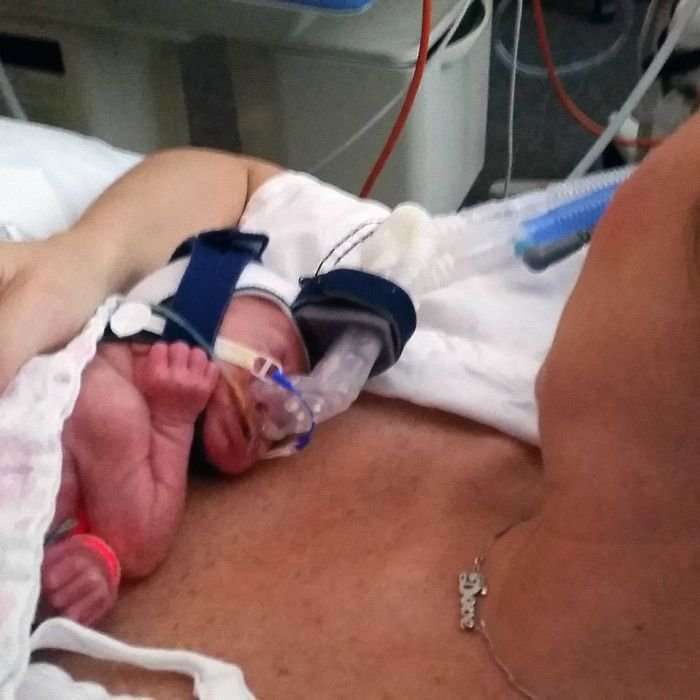Premature babies: Simple procedure by Australian doctors could save thousands of lives each year
The lives of tens of thousands of premature babies could be saved by simply delaying clamping the umbilical cord by one minute, according to Australian doctors.
Key points: Waiting 60 seconds before clamping umbilical cord could save thousands of premature babies
Australian doctors say findings will change how premmie babies are treated
Doctors say delaying clamping is safe for mothers and babies
The team of doctors from the University of Sydney reviewed the findings of 18 clinical trials around the world, involving almost 3,000 babies born before 37 weeks' gestation.
They found waiting 60 seconds before clamping the umbilical cord reduced the risk of deaths by one third.
University of Sydney professor Jonathan Morris said delayed clamping was standard practice in full-term babies, as it had been shown to help babies adapt better to life outside the womb.
Professor Morris said the new research showed it was safe for premature babies too, and it could change how they're treated.
"It meant for every 20 babies born at less than 28 weeks that received delayed cord clamping, one extra baby would survive," he said.
"This is such a significant finding because it's such a simple intervention."
He added that almost every pre-term baby could benefit.
"Not only is it simple, safe and effective, but it saves lives," he said.
"This is such a significant finding because it's such a simple intervention and it saves lives. It's available to every baby born pre-term and it doesn't cost anything."
Do you know more about this story? Email [email protected]
Professor Morris said there were several theories why clamping may be beneficial for premature babies.
"It may be that the baby has more time to adapt itself," he said.
"Is it because there is extra blood in the baby's system? Or possibly, it's affecting the baby's resistance to infection because of an added transfusion of white blood cells."
Most premature babies will begin breathing by 60 seconds on their own.
So the delay "may avoid unnecessary and potentially harmful interventions" such as breathing tubes, the doctors found.
Research also found it reduced the need for blood transfusions.
'I am very humbled to have had this technique'
Dove Wiseman-Liversage was 26 weeks' pregnant with Skye when she went into premature labour.
She was part of the ground-breaking study, with doctors holding off clamping Skye's umbilical cord for 60 seconds.
"It's really amazing what science can do," she said.
"Skye is really healthy. We haven't been to hospital and she's thriving, so we're very, very grateful."
Professor Morris said he estimated an extra 2,300 Australian babies would survive each year because of delayed clamping.
"In the world, where there are a million babies born pre-term, literally there will be thousands of babies that are saved by this," he said.
Baby Skye is now a healthy 17-month-old, with a sibling due early next year.
"If this baby was to come early, I'd know we have this technique in place and I'd feel more at ease I guess knowing how beneficial it is," Ms Wiseman-Liversage said.
The findings will be published in the American Journal of Obstetrics and Gynecology.
Topics: babies---newborns, family-and-children, community-and-society, babies, australia

sweetepitome on October 30th, 2017 at 12:35 UTC »
NICU nurse here- we do this in the US. All babies get 60 seconds unless otherwise indicated. It’s done with premies too, but there are other risk factors that come in to play with early babies. There is a reason that baby came early, including possible abruption or failing placenta. Delayed cord clamping is not always indicated. The OB will do a pulse check, but if the heart rate is low enough to resuscitate the cord is cut and baby is handed over to the resus team. Oxygen doesn’t do the body any good if there isn’t an adequate heart rate to pump it where it needs to go. Additionally, you risk the premie getting cold which can be very dangerous to them. The resus team focuses on establishing heart rate, breathing, and an adequate temperature to stabilize the baby before transporting to NICU. If something is going on with Mom, the OB might forego cord delay as well as the resus team can care for the baby but the OB is in charge of Mom. Ex: an abrupting or hemorrhage Mom means cord clamping is ineffective and dangerous.
But otherwise delayed cord clamping is great! It might save the babies from a couple of transfusions. We get really red full term babies, and yes jaundice is an issue. It’ll be interesting in a few years if meta analysis shows this simple technique has really improved survival!
MedlifeCrisis on October 30th, 2017 at 10:21 UTC »
This is not new. Delayed cord clamping has been studied in preterm and very preterm babies for over a decade. It has been shown to improve outcomes in a number of areas such as bleeding in the brain, infection rates, growth, haemodynamic (circulatory) stability and blood transfusion requirements.
https://www.ncbi.nlm.nih.gov/pmc/articles/PMC1564438/ (2006) https://www.ncbi.nlm.nih.gov/pubmedhealth/PMH0011919/ (2011) https://www.ncbi.nlm.nih.gov/pmc/articles/PMC3356138/ (2012) https://www.ncbi.nlm.nih.gov/pubmed/27776037 (review from 2016) https://www.ncbi.nlm.nih.gov/pubmed/26819134 (review from 2016)
And loads more. It's just the usual media hype.
quarkylittlehadron on October 30th, 2017 at 09:32 UTC »
If this is the practice with full term babies for a reason, why might it not have already been applied to pre term babies? Why is this groundbreaking?